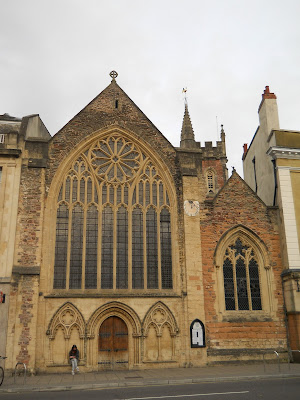This church is in the centre of Bristol, next to the Council House. It's quite appropriate, as it is apparently the only municipally-owned church in the country.
The church was built in the thirteenth century to serve the Hospital of St Mark, which was founded by Maurice de Gaunt. It was a monastic hospital and for over three hundred years it gave food and care to one hundred poor people a day.
When Henry VIII broke up most of the monasteries during the Dissolution in the sixteenth century, the Hospital was surrendered and the Bristol Corporation (the city council) bought the lands belonging to it in 1541. It was used by various local schools and was granted to French Hugenot refugees as a place of worship in 1687.
In 1722, it became the official place of worship for the Mayor of Bristol and the Council and it has remained so to the present day. This was in part because of a dispute with the Cathedral, which faces the Lord Mayor's Chapel across College Green. In 1788, the Mayor got his own back by allowing John Wesley to preach in the chapel when the Bishop of Bristol had forbidden Wesley from preaching in any of the city's churches.
There are several interesting things kept at the Chapel, including the ceremonial swords of the Bristol Corporation. Unfortunately, one of the most interesting chapels had building work going on due to repairs to the church organ, so it's stone memorials couldn't be photographed. Helpfully, the interesting features of the chapel have information boards near them.
These stone corbels date to the thirteenth century and would have jutted out from the walls to hold up the roof. They may have been used as infill in the walls later, or were taken out during restoration work in the nineteenth century. Nearby are some medieval wall paintings on display, moved from elsewhere in the chapel.
The oak choir stalls have some beautifully carved misericords under the seats and carved faces as bench ends. Many of the faces are of Green Men. Here are a few:
How old do you think these carvings are?
Well, although they look quite medieval, they were actually carved far more recently. The choir stalls were only installed in 1888! The crispness of the carving does give the game away a little. They don't show much wear and the finish is much more precise than is usual with medieval carving (I suppose that reflects the advances in the making of carving tools during the nineteenth century). The expressions and the foliage carving are wonderful all the same.
If you would like more information, the Chapel website can be found by clicking here. It is usually open 10am-12pm and 1pm-4pm from Wednesday to Sunday, but it's worth checking before you visit by calling the Lord Mayors Office on 0117 903 1450.











No comments:
Post a Comment